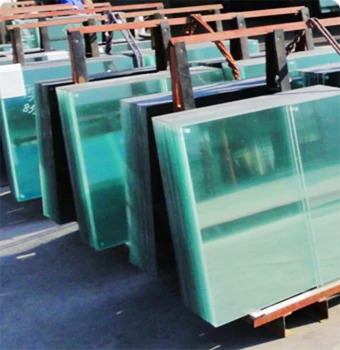Tempered glass, also known as toughened glass, is a type of safety glass that is manufactured through a process of extreme heating and rapid cooling. This process enhances the strength and thermal resistance of the glass, making it ideal for various applications, including in buildings, automobiles, and electronic devices.
The tempered glass process begins with selecting a suitable type of glass, typically float glass, which is known for its uniform thickness and clarity. Once the glass is chosen, it is cut to the desired size and shape. Precision is critical at this stage, as any imperfections can compromise the entire production process.
After cutting, the glass undergoes a cleaning process to remove any dust, dirt, or grease. This step is crucial because contaminants can lead to defects during the tempering process. Once the glass is cleaned, it is ready for heating. The glass is placed in a furnace where temperatures can reach up to 620 degrees Celsius (about 1,150 degrees Fahrenheit). This heating phase allows the glass to reach its softening point, making it pliable.
After reaching the appropriate temperature, the glass is removed from the furnace and subjected to rapid cooling, or quenching. This is achieved by blowing cool air onto the glass surface. The rapid drop in temperature creates a balance of internal stresses; the outer surface cools and solidifies faster than the inner part, resulting in a hardened structure. This thermal treatment increases the overall strength of the glass, allowing it to withstand impacts and high thermal variations that ordinary glass cannot endure.
tempered glass process
The quality of tempered glass is evaluated through rigorous testing methods, ensuring it meets safety standards. When broken, tempered glass shatters into small, blunt pieces rather than sharp shards, minimizing the risk of injury—an essential characteristic for safety applications.
The applications of tempered glass are vast and varied. It is commonly used in residential and commercial buildings for windows, doors, and facades due to its strength and aesthetic appeal. In the automotive industry, tempered glass is used for windshields and side windows. Additionally, it is employed in electronic devices, shower doors, and glass partitions, making it a versatile component in modern architecture and design.
In conclusion, the tempered glass process is a sophisticated manufacturing method that transforms ordinary glass into a strong, safe material suitable for numerous applications. Its ability to resist thermal stress and minimize injury upon breakage underscores its importance in modern construction and design.
 Afrikaans
Afrikaans  Albanian
Albanian  Amharic
Amharic  Arabic
Arabic  Armenian
Armenian  Azerbaijani
Azerbaijani  Basque
Basque  Belarusian
Belarusian  Bengali
Bengali  Bosnian
Bosnian  Bulgarian
Bulgarian  Catalan
Catalan  Cebuano
Cebuano  Corsican
Corsican  Croatian
Croatian  Czech
Czech  Danish
Danish  Dutch
Dutch  English
English  Esperanto
Esperanto  Estonian
Estonian  Finnish
Finnish  French
French  Frisian
Frisian  Galician
Galician  Georgian
Georgian  German
German  Greek
Greek  Gujarati
Gujarati  Haitian Creole
Haitian Creole  hausa
hausa  hawaiian
hawaiian  Hebrew
Hebrew  Hindi
Hindi  Miao
Miao  Hungarian
Hungarian  Icelandic
Icelandic  igbo
igbo  Indonesian
Indonesian  irish
irish  Italian
Italian  Japanese
Japanese  Javanese
Javanese  Kannada
Kannada  kazakh
kazakh  Khmer
Khmer  Rwandese
Rwandese  Korean
Korean  Kurdish
Kurdish  Kyrgyz
Kyrgyz  Lao
Lao  Latin
Latin  Latvian
Latvian  Lithuanian
Lithuanian  Luxembourgish
Luxembourgish  Macedonian
Macedonian  Malgashi
Malgashi  Malay
Malay  Malayalam
Malayalam  Maltese
Maltese  Maori
Maori  Marathi
Marathi  Mongolian
Mongolian  Myanmar
Myanmar  Nepali
Nepali  Norwegian
Norwegian  Norwegian
Norwegian  Occitan
Occitan  Pashto
Pashto  Persian
Persian  Polish
Polish  Portuguese
Portuguese  Punjabi
Punjabi  Romanian
Romanian  Russian
Russian  Samoan
Samoan  Scottish Gaelic
Scottish Gaelic  Serbian
Serbian  Sesotho
Sesotho  Shona
Shona  Sindhi
Sindhi  Sinhala
Sinhala  Slovak
Slovak  Slovenian
Slovenian  Somali
Somali  Spanish
Spanish  Sundanese
Sundanese  Swahili
Swahili  Swedish
Swedish  Tagalog
Tagalog  Tajik
Tajik  Tamil
Tamil  Tatar
Tatar  Telugu
Telugu  Thai
Thai  Turkish
Turkish  Turkmen
Turkmen  Ukrainian
Ukrainian  Urdu
Urdu  Uighur
Uighur  Uzbek
Uzbek  Vietnamese
Vietnamese  Welsh
Welsh  Bantu
Bantu  Yiddish
Yiddish  Yoruba
Yoruba  Zulu
Zulu 

